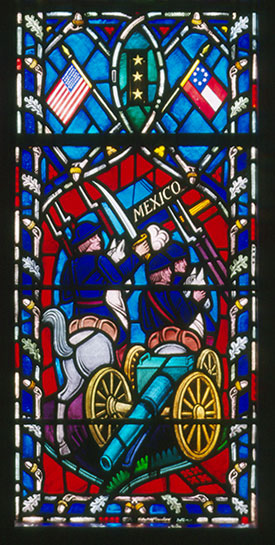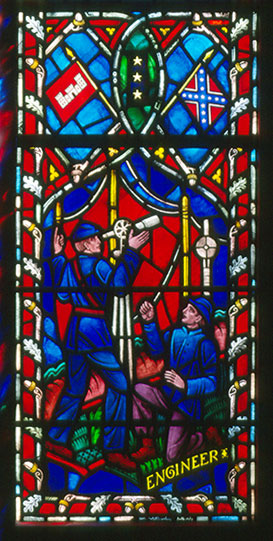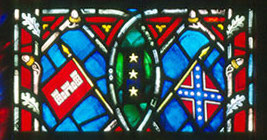
A stained-glass window honoring Confederate General Stonewall Jackson installed at the Washington National Cathedral. The windows are the work of Wilbur Herbert Burnham of Boston. Photo courtesy of Washington National Cathedral
WASHINGTON (RNS) The dean of Washington National Cathedral has called for two stained-glass windows featuring Confederate flags to be taken down from the Gothic edifice, in yet another instance of institutions reconsidering countless tributes to the Southern cause.
“It is time to take those windows out,” said the Very Rev. Gary Hall in a Thursday (June 25) announcement.
The prominent building on the skyline of the nation’s capital includes windows honoring Confederate generals Stonewall Jackson and Robert E. Lee, and each contains an image of the controversial flag.
“The Cathedral installed these windows, in part, because its leadership at the time hoped they would foster reconciliation between parts of the nation that had been divided by the Civil War,” said Hall, who has called for the governing bodies of the cathedral to remove the windows that have been there since 1953.
But at a time when the nation is mourning the killings of nine people at Emanuel African Methodist Episcopal Church in Charleston, S.C., allegedly by a shooter who embraced the flag, Hall said the cathedral should take a different approach. He also cited the recent killings of unarmed black men at the hands of police officers.
“Here, in 2015, we know that celebrating the lives of these two men, and the flag under which they fought, promotes neither healing nor reconciliation, especially for our African-American sisters and brothers,” Hall said.

A stained-glass window honoring Robert E. Lee installed at Washington National Cathedral. The windows are the work of Wilbur Herbert Burnham. Photo courtesy of Washington National Cathedral
The cathedral’s announcement comes as religious and political leaders have called for the flag to be taken down from the grounds of the South Carolina State House and elsewhere. On Wednesday, the board of visitors of The Citadel, The Military College of South Carolina, voted 9-3 in favor of removing the Confederate Naval Jack from its chapel “to an appropriate location” on its campus.
“I think this is a major, major statement now, continuing with sort of the domino effect that has occurred across the country, to remove any vestiges of the Confederacy because it has become painfully apparent to all of those who defended it for so long that it is offensive,” said history professor Jason Silverman, an expert on the American Old South at Winthrop University in Rock Hill, S.C. “It’s now being interpreted as being dangerous.”
Given the nature of the cathedral space, Hall said, a change in the windows will take “time, energy and money.” In the interim, he said, a display will be placed near the windows “to explain them in their historical context.”
“We will gather a representative group to work with us to imagine how new windows can best represent our shared history of war and peace, racial division and reconciliation,” he said. “We will also discuss the future of the Jackson and Lee windows.”
Silverman, who visited the cathedral a few years ago during a trip to Washington, said he noticed the red and blue panels that featured the Confederate flags and thought it was “really odd” that the cathedral included them.
He noted that the decision to install them came just before the 1954 landmark Brown v. Board of Education decision against school segregation.
“I’m almost thrilled, in one sense, chronologically, that it comes sort of right on the cusp in the 1950s before everything changes,” said Silverman. “I can’t believe that would have even been proposed in, say, ’57, ’58, ‘59 or ’60.”
YS/MG END BANKS





